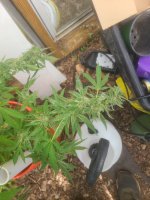slyman
Member
Humidity isn't very high. Saw a couple spots in the last couple weeks but took care of them immediately. Nothing was on it yesterday and then today there's a ton
Guessing powdery mildew, there was another similar fungus I had an issue with last year. Also am I understanding correctly the pm is internal? So it's basically throughout the plant and these are just fruiting bodies? Have on other plant that is completely fine and further along than this one. Especially annoying when it's so close to being done.
Plant is in organic soil
Would we be best off just chopping now?
Guessing powdery mildew, there was another similar fungus I had an issue with last year. Also am I understanding correctly the pm is internal? So it's basically throughout the plant and these are just fruiting bodies? Have on other plant that is completely fine and further along than this one. Especially annoying when it's so close to being done.
Plant is in organic soil
Would we be best off just chopping now?
Attachments
Last edited:







